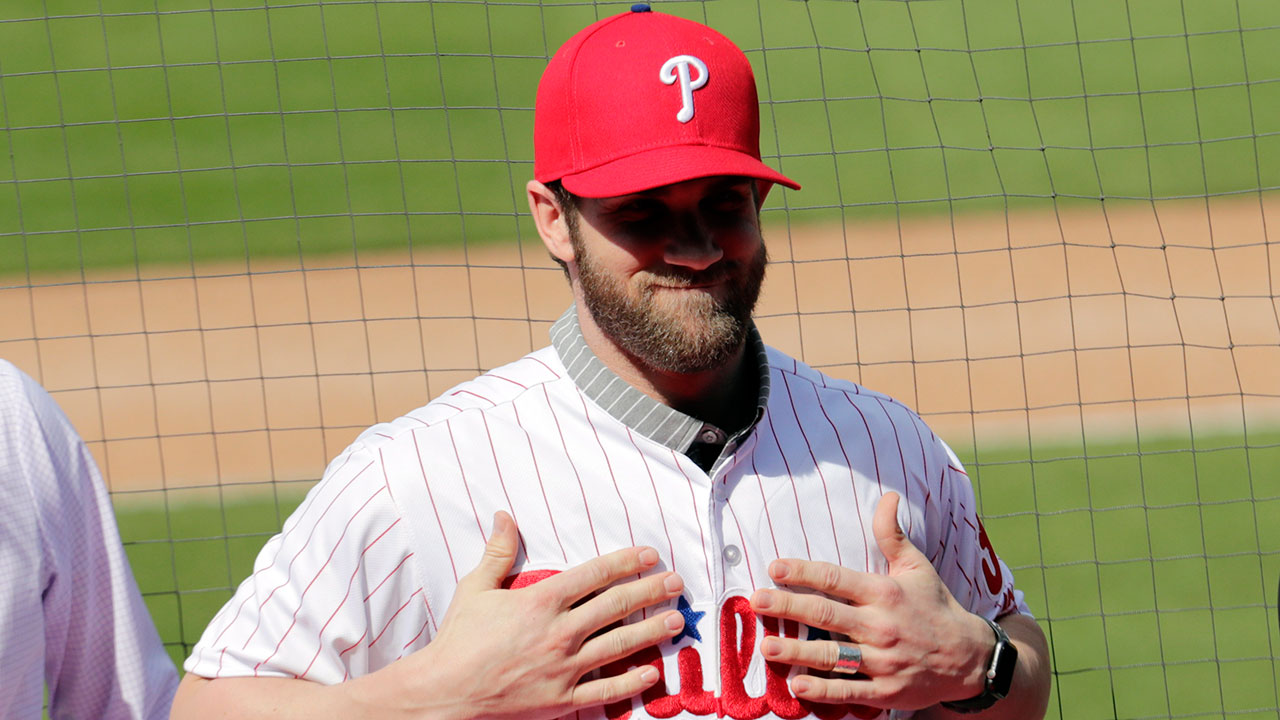CLEARWATER, Fla. – Early Saturday afternoon at Spectrum Field, dozens of media members, select fans and one green-haired mascot gathered in anticipation in the first base stands. The focus of their attention: Bryce Harper, who had officially agreed to the biggest contract in baseball history the previous day.
Just after 2 p.m., the winter-long wait ended. Harper emerged from a stadium tunnel, climbed up a set of hastily-built stairs and walked onto the visiting dugout, where he bro-hugged the Phillie Phanatic, waved to the applauding fans and took his seat behind the temporary dais.
He wouldn’t have been there without the 13-year, $330 million commitment owner John Middleton had approved days earlier. Money talks, and elite players know their worth.
As Harper noted, “baseball’s worth $11.5 billion (annually), I think some of that should go to the players.”
At the same time, it would be a gross oversimplification to say that the Phillies simply wrote a big check. They connected with Harper personally, inviting his wife Kayla in the process, and wooing the couple with videos and gifts. Middleton and his wife were intimately involved, flying to Harper’s home in Vegas and telling stories over dinner. The theme of family was clearly important to Harper, who asked for a contract with no opt-outs.
“I wanted to be able to dig my roots somewhere through the ups and downs,” Harper said. “It’s going to be tough for our team to win every single year, I understand that. Even through the bumps and bruises, the goods and the bads, I want to be a part of that.”
[snippet id=3305549]
That kind of coordination requires ‘dozens, and dozens and dozens’ of people, as general manager Matt Klentak pointed out. Everyone from the social media team to the clubhouse manager to the team’s players get involved in a pursuit that big.
Simply put, landing a free agent of this magnitude requires more than a few phone calls or texts. Either you’re all-in or you’re far off on the periphery.
Watching Harper’s introduction unfold, you can sense a contrast between the complete buy-in from the Phillies and the many clubs whose interest was more exploratory. The Blue Jays, who lost 6-5 to the Rays in nearby Dunedin Saturday, fall into the latter category. Harper was a fit in Toronto on paper, as many fans rightfully noted, and GM Ross Atkins has acknowledged that the Blue Jays at least ‘contemplated’ the 26-year-old.
So, did that contemplation ever lead to anything more?
“Not a lot of conversations,” said one source familiar with the talks. “Some, but not a lot.”
A second person said the Blue Jays checked in with all of Boras’ top clients, including Harper, Dallas Keuchel and Marwin Gonzalez. Beyond that, talks never got serious.
To some extent, it’s simply a product of where the Blue Jays are as a franchise right now. They’re rebuilding, far enough away from contention that no one player would push them into Yankees or Red Sox territory.
Plus, with Middleton in charge as managing partner, the Phillies are structured differently than the Blue Jays, who are owned by Rogers, a publicly traded company. Eventually, the Blue Jays will spend big, according to team president and CEO Mark Shapiro, but it’d be a surprise to ever hear anyone from this team wonder aloud about spending ‘stupid’ money the way Middleton did.
“I’m 100 per cent confident that when we say the foundation is there, that we need to spend and surround these players with other players, that the support will be there to spend more on major-league payroll,” Shapiro said on The Lede podcast last fall. “Whether that puts us at third or sixth or seventh (in MLB), it should be enough to win and win a World Championship. I don’t see that as a concern or excuse.”
Based on that, the money will be there when the Blue Jays choose to augment a core built around the likes of Vladimir Guerrero Jr., Bo Bichette, Danny Jansen and Ryan Borucki. How they choose to spend it will be interesting, as the Blue Jays have been cautious in free agency under Shapiro, maxing out with J.A. Happ’s $36 million contract to this point.
In theory, they could go after the next big free agent, whether it’s Gerrit Cole, Mookie Betts or Francisco Lindor. It’s also possible that the Blue Jays choose to spread their free agent spending around and diversify their risk. Maybe they spend on their versions of Jake Arrieta ($75 million, three years), Andrew McCutchen ($50 million, three years) and David Robertson ($23 million, two years) without setting any records.
[relatedlinks]
For this Blue Jays front office to commit huge dollars to a free agent, they’d have to do extensive background work on the player’s character and come away convinced that he was worth it. Small deals are easy to move on from when they become problematic. If Bud Norris were to step out of line, for example, the Blue Jays would simply release him. But once you commit hundreds of millions, you’re more tightly bound together, and investing in the wrong player could be immensely harmful.
At Spectrum Field, the Phillies and Harper seem legitimately excited for what’s ahead. With a hugely-improved roster, an owner willing to spend and a 26-year-old superstar entering his prime, they should be. Eventually, other teams may thank themselves for their prudence, but in the meantime, this moment’s theirs to enjoy.
— — —
HARPER HONOURS HALLADAY
Harper wore No. 34 in Washington, but he arrived in Clearwater wearing No. 3 Saturday. Why? Harper said his brother and father have both worn the number, but that’s not all. As he considered his options, Harper was also conscious about respecting the legacy of a former Blue Jays and Phillies great.
“Of course I wore 34, but I thought Roy Halladay should be the last one to wear it,” Harper said. “For me it’s Roy Halladay. He’s 34. He represents that number in Philly.”









